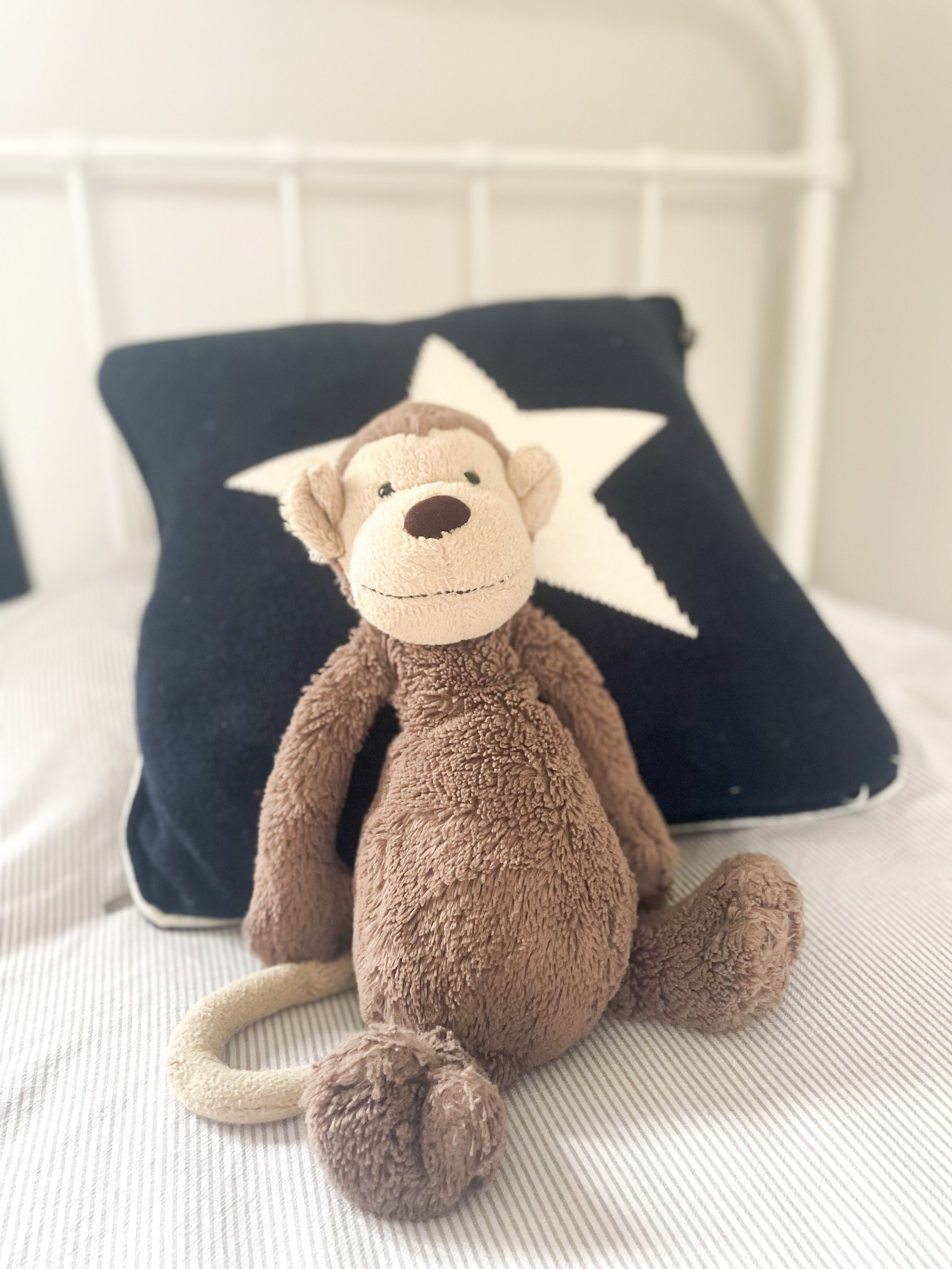Home Design Essentials: How to Style a Beautiful Kids Bedroom
Styling a kid’s bedroom is about creating collections of things that make them smile.
When it comes to our design projects, they’re a bit like children - you don’t have a favourite, each one is special in their own right. But designing kid’s bedrooms? Well we might have a little soft spot. There’s something magical about it. I was lucky enough as a kid to have my own bedroom that was my sanctuary. I can remember playing in there for hours, storming up there and slamming the door (my poor parents!) and hanging out with my friends in our own little space. Kid’s rooms, almost more than any other room need to be full of personality. Check out our top tips on how to add personality to your space. They need a space that can grow with the child and a place that they feel is all theirs - a safe haven. A child’s bedroom design needs to be calm enough to sleep in, exciting enough to play in and flexible enough to grow in. Getting that right can be quite the challenge.
So much of the personality can be injected into a kid’s bedroom design in the styling. It’s a great way of adding personality that’s not permanent. Styling can easily be changed, swapped out or updated as the kid grows. I’ve put some simple tips together for styling a kids room that are easy and affordable to achieve and some of them can be done in under an hour.
The Basics
Home styling is the process that happens generally after the decoration - the finishing touches. But there are a few key basics that every kids room should have before you start. First of all a good black out blind. I think I speak for most parents when I say that a sleeping child equals happy parents. Anything that helps this in my book is essential, so I always recommend a good black out blind. I like to add most of the colour in a room through the styling so I often opt for a warm neutral on the walls. I love Farrow and Ball Strong White or Dulux’s Almond White. They both bring a lovely warmth to a room. Then the last one here is storage- if everything has it’s place it’s easy to keep the room tidy, which in my experience is a tough one with kids, so anything that makes that easier helps. I love the Malm range from Ikea. It’s simple, well sized and easily fits into most schemes. Ikea’s Kallax storage is also great for storing toys and games, it’s one of our staples.
Designs from a recent kid’s bedroom design in our Shoreham project
Finally some kind of display is always a good idea. We love adding shelves to a kids bedroom - A place to show off all the personal bits and pieces from Lego creations to money boxes and teddies. A few shelves make the walls more interesting too. You can think out the box on this one. We’ve made shelves from old fence slats, painted and mounted wooden storage boxes on the wall as shelves or simply used shop bought shelves and made them more interesting with smart looking supports. Just make sure they’re sturdy and away from bright sunlight as things will fade in bright sunshine.
So that’s the basics. With a neutral canvas to work on the fun stuff can begin.
The Bed
Ultimately this needs to be appealing to entice them in! This needs to be led my the child and how they like to sleep. My daughter loves to go to bed cocooned in a million stuffed animals. I try and keep these to a minimum as they’re a distraction at bedtime but it’s mostly about the comfort so she has a few lovely soft cushions that she can create a nest with. She gets cold so always has a couple of blankets at the end of her bed that she can pull up if she wants to. Because it’s so busy I keep her bedding quite plain and light in colour so it doesn’t look too busy.
My son on the other hand like things much plainer. He has one teddy who takes pride of place on his pillow and that’s it. He has one quite bright and colourful duvet set and one much plainer one and we swap and change. I find it difficult to get nice cotton bedding for kids at a good price - Cotton is so much more comfortable. We have found a lovely basic again in Ikea , the Bergpalm which is 100% cotton and only £20 for a single set. There are a few colours. H&M Home also have more lovely cotton options. I’m afraid I’m not a fan of the big bright branded stuff. Generally it’s scratchy and plasticky I prefer a softer cotton option and put the characters in posters or on the shelves as models.
The Walls
Which brings us on to artwork and decorating the walls. Firstly the number one tip here is to go big. One small A4 framed picture in the middle of a wall does nothing for anyone. there are two nice options here. Either go for a great big framed print or fill the same space you would with one, with a collection of frames items in a gallery wall. Keep them relatively close together. If you’re going for a rough collection of sizes and shapes, always have an odd number, it looks better. If you’re going for a symmetrical collection of same size frames, keep them in even numbers. Just make sure you get your spacing right. There are loads of hints and tricks on Pinterest for hanging gallery walls if you’re uncertain.
Add areas in the room where kids can display their achievements
Books are a great way of adding colour into a kids bedroom scheme
There are lots of ways to display artwork like this magnetic hanging frame
Adding artwork doesn’t have to be expensive. There are some lovely prints out there, but you can also frame your kids art. Our kids love to have their own work on the walls and you can switch it up as they go on to create new masterpieces. The Range are great for affordable frames that are good quality. Try mixing them up a little or using something different like a magnetic frame to shake up the loook.
Shelf Styling
As seen on our Instagram We painted wooden storage boxes to use as shelves, creating an area to display favourite things
This is the best bit! Start by creating a real life mood board. grab a collection of your childs things that you think really reflect their personality and the things they love. This may be a toy car or dinosaur, a football, a photo of them and their friends or a stone that they picked up from the beach. Anything that will make them smile an feel happy. Try and gather a selection of things that are all different shapes and sizes. Then arrange them on the shelves. Don’t think too hard about this one, that’s when it all goes wrong! Put the tall things at the back. You can layer things to make the shelves look more interesting by stacking objects or putting a lego model on top of a pile of books. If you’re trying to stick to a certain colour palette in the room then use things that are a range of tones in that colour. Lay them out and play around with it all until you’re pleased with it. It might take a week or so of playing around but you’ll get it right. Create a personal display for your kids that can be updated as they grow.
Zoning
Sometimes, particularly smaller children, need to be encouraged how to play. If you have the space, zoning is a good idea. Create a ‘zone’ for each are of the room. A space for homework, a reading corner or a play area. Make sure each area has whats needed, books in the readying area, toys in the play area. A rug is a nice way of making the zoning more obvious. We create a space for a client recently with a Barbie area on a large rug that stopped the carpet getting ruined but zoned the play area perfectly.
Layer up the window
Creating a real life mood board
To cosy up the room, curtains are a good way of softening the lines. Curtains over the roller blind are a great option for either adding another layer to block the sunlight or just softening the space by styling curtains that don’t have to be used. This can be done with much thinner curtains which are really affordable. It’s also a good way of getting your colour palette into the room and adding some colour or pattern to the scheme.
Lighting
It’s a good idea to have a few different options on the lighting front. The main light needs to be functional. Putting that on a dimmer in a bedroom is always a good idea. I always add a bedside light making sure that the light it gives is a warm white that’s cosy and relaxing. This can be used for reading. Then if you child does homework or artwork in their room then a desk light is a good idea. In larger rooms you can think of the different light options in your zones, but in smaller rooms always have a secondary light to the main light to use at bedtime for a more calming atmosphere.
Finally, if you’re planning a new design for your child’s bedroom, creating a mood board is a really good idea. It’s how we work with our clients. A physical one works really well. Gather everything together including the duvet cover, curtains, etc and lay it all out on the carpet. See what you need to add or take away. Otherwise Google Slides or Powerpoint is great. Either use photos or pictures from Google of the things you have and put them all together. The only thing to watch with this is the size and relation to the design. Make sure that you’re bigger items like the duvet are larger in size on your document to smaller objects that you might add to a shelf to make sure you get the right balance.
The most important thing to remember when you’re styling a kid’s bedroom is to have fun with it. Don’t rush it, plan it and have fun. Try things and give things a go - If you don’t like what you’ve done just change it around until you do.
A recent project we worked on to design a little girls bedroom











